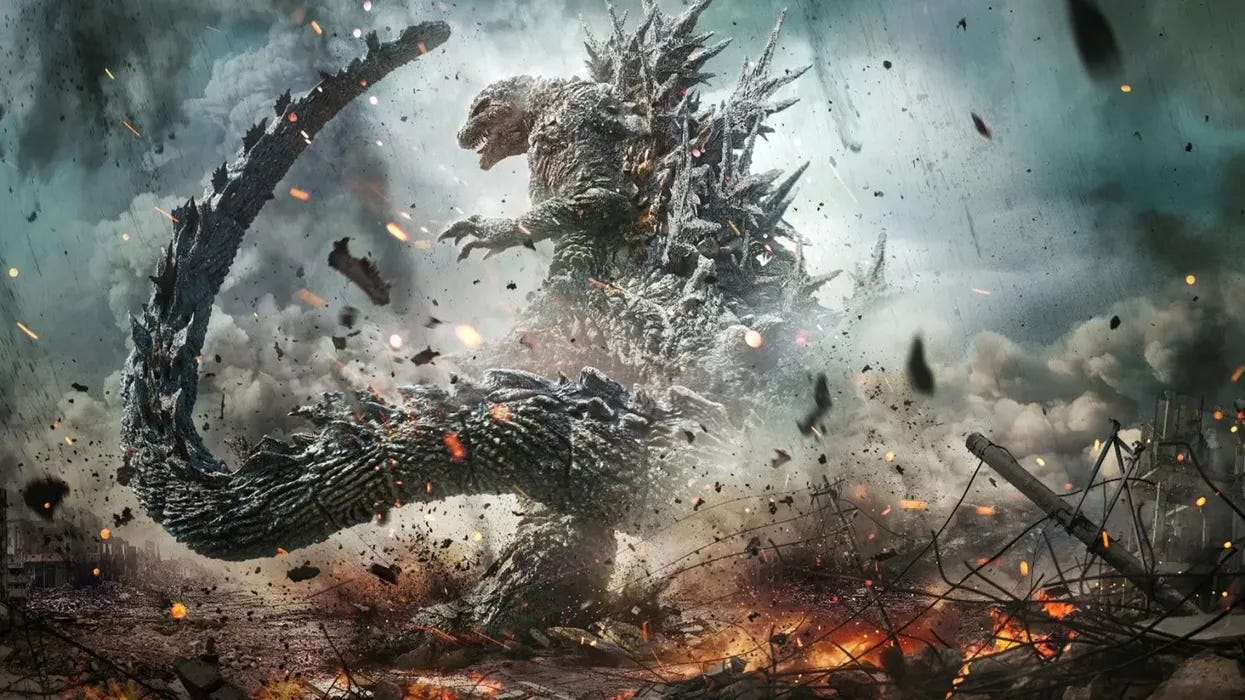"Godzilla Minus One" Offers More Melodramatic City-Demolition
The movie compares better to recent gargantuan blockbuster fare, but it's still a Godzilla flick
Roaring onto streaming services this week in the U.S. is the much-lauded “Godzilla Minus One,” beloved by critics and Internet bros, so much so that my 3-of-5 star rating on letterboxd triggered a couple of them to take emotive shots at me.
Now my word of warning is that I accidentally saw a different version of this than others. On Amazon, there are two unlabeled HD options. I rented the first one. Then the movie started in black and white. "Oh, no color?,” I said. “Bold choice!"
Turns out I actually watched "Godzilla Minus One Minus Color,” a novel, de-colorized version that probably tainted my views of the movie to some extent, though I don’t think very much.
Also, you might be asking, as two of my children did, what the “minus one” in the title means? I decided to act like a normie moviegoer and not look it up, figuring it out for myself.
Well, given that method of discovery, I still don’t have a clue what the mathematical title means. You’ve got me, moviemakers!
From what I can tell, “Godzilla Minus One” revives the original 1954 classic that spawned so many terrible B-movie monster flicks that we’re still yucking it up about “Godzilla vs. Mechagodzilla” and the ridiculous Mothra spinoffs in my household. In contrast to those, this movie is ultra-serious.
It’s so serious that it teaches us, helpfully, what the aftermath of WW2 was like for the Japanese. Herein, we will learn how they cleared sea mines, and why they used wooden boats to do so. The movie liberally quotes the classic, harrowing Studio Ghibli movie “Grave of the Fireflies” on the results of the firebombings of Tokyo and Japan in general.
As a kind-of remake of the original Godzilla, “Minus One” starts in WW2 and ends somewhere about 1948. The main character is a failed kamikaze pilot. We know he failed because he’s alive, and he’s given grief over this by fellow Japanese soldiers, even though in his first encounter with Godzilla, he’s the only man spared. Presumably, this is because he’s not a warrior at heart.
But should he be? Yes, maybe, because when he returns to Japan in the fall of 1945, he feels terrible about his lack of courage.
In a Chaplin-esque manner, he adopts a single woman and an orphaned child, who live with him in the bombed wreckage of a shack. Slowly, over the next two years, their lives and the city are rebuilt. He takes a risky job as an ship-based clearer of mines.
And yet Godzilla lurks, as he always does.
What I think happens in “Minus One” is that Godzilla is a giant version of a komodo dragon on a small, remote Pacific Island. The movie hints that nuclear testing mutates Godzilla — or maybe I’m just reading into it? — and that this monstrous dragon, as usual, comes toward Japan because it’s really ticked about something.
The protagonist and his friends must figure out how to stop this city-wrecking creature from coming ashore. When that fails, they must figure out how to sink the monster, because no weapon can do damage to it. The movie values a private, volunteer effort on the part of the Japanese, because their government and the US military can do nothing for them.
Now the protagonist, as in the case of Hollywood melodrama rules, must make amends for his WW2 failures. Here the movie toys with undesirable meanings, which seem to have escaped most critics who have lauded it to the heavens.
I pause here to teach a bit.
When your main character is a failed ex-kamikaze, and the plot arc of this character necessitates redemption, what values does your plot arc extol? In this case, the only thing it could extol is . . . to be a true kamikaze! That means killing yourself for the cause of the nation, or your people.
How does that sound to most of you? I realize it sounds great to the ancient Spartans or to the rampaging Valhallaites in the recent Mad Max movies, but I don’t think this particular value ought to be championed as much as it is here.
I mean, the plan to quell Godzilla includes the protagonist flying a plane loaded with bombs into Godzilla’s mouth.
If I told you that this movie is a Hollywood melodrama, what do you think will happen in the end? By the logic of cinema, it cannot be that he actually does fly the bomb-laden plane into Godzilla’s mouth. And that’s because the moviemakers would be glorifying the principle of kamikaze pilots.
Still, as I said, the fact that an ex-kamikaze pilot needs to redeem himself strikes me as a risky, even troubling plot point. What exactly does he need to redeem himself from? From not crashing his plane suicidally into Allied forces? To my grandfathers and great-grandfathers, it would seem okay that he didn’t do that at all! “No need to redeem yourself, son; you did the right thing!”
I say all this, and yet I might be giving the movie too much credit.
As with all fantastical movie-monster fare, there’s a strong tension — or contradiction? — between the melancholy sweetness of the melodrama and the strong lust on a viewer’s part to see Godzilla smash things.
It’s always as if I am supposed to feel strong human emotions, featuring love and sadness and all manner of pathos, while watching a monster-truck rally.
I don’t know, reader. When I’m at a monster-truck rally, I just like to watch things get smashed. And that’s again what happens all over this Godzilla movie.
I think all of this confusion comes out of WW2 to an extent, though it goes back even to the first King Kong movie in the early 1930s. There’s a weird tension between wanting to experience liberalized human feelings and also wanting to watch civilization get annihilated by forces much larger and more powerful than it.
Both are in play in monster-movie fare, and that strong tension is probably even best described as a form of cognitive dissonance.
The way these monster movies resolve that dissonance is by devolving into campy B-movie fare. That’s been the way of the sequels to the Godzilla movies, the Kong movies, the Planet of the Apes movies, and so on. It happens often even by the second movie, which “Minus One” nearly promises in its final shot.
Don’t get me wrong: in context of our current evil movie age, and in comparison to the gigantic blockbusters, including the American Godzilla fare, this "Godzilla Minus One" does really shine.
However, my Contrast Principle stands firm. What are we really comparing this movie to? To what standard? To what other films? If the comparison is to Marvel fare and to the American Godzillas, critical judgments and higher ratings seem warranted.
But in comparison to what we actually have at the touch of our fingers, which is not just the entirety of movie history, but the entirety of recorded-and-preserved entertainment from the last 3000 years, I don't think this Godzilla is all that special.
It's a fine, watchable, digestible, forgettable film that uses basic character types to create basic messages about generally good values — such as bottom-up private efforts to save civilization — in the midst of melodramatic, highly emotional, big-screen moments.
Now, in color, would this look and watch better? Was my experience diminished by seeing “Minus One” in “Minus Color”?
I doubt it. That color scheme offers a retro feel, while Godzilla himself arguably looks more realistic and more menacing. Black-and-white seems achier to me, and it can enhance melodrama. My bet is that it’s a *better* choice for viewers who loved the film.








Minus One's dependence on living with post-war guilt and trauma made it stand out from just about every kaiju catastrophe movie I can recall. There's something in Japanese popular culture about the slim possibility of happiness, about frailty and enduring tragedy. That runs through Shusaku Endo's novels, in the recent Japanese-American production of Shogun, lots of manga and anime, and the distinctive character of Japanese horror/ghost movies. My wife asked me after Minus One, "Is there an explanation for Godzilla's goals or reasoning?" I guess that's it; Godzilla behaves like other catastrophes that just happen, and are cruelly and indiscriminately destructive. Yamazaki has earned some criticism for his so-called left leaning jingoism, but I didn't see that in Minus One. It's criticism of government indifference and corruption is clear, and you may have a point about its attempt to "redeem" the kamikaze pilot. However, that felt to me like a depiction of an damaged man obsessed with the one "tool" he believed he still had left to save his country. I agree that we film viewers should ask why we enjoy these kinds of movies. When I teach on the rise of modern fascism, I illustrate The Futurist Manifesto with the Tumbler cop chase scene from Batman Begins. I argue that our taste in such chaos and assaults on property and civic authority suggests a modernist taste, not unlike our taste for ruins and watching our modern monuments destroyed in film. Its an eerie thing to consider.